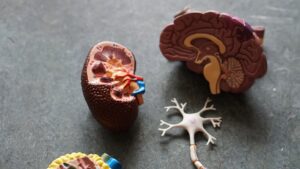
Along with a healthy lifestyle and regular chiropractic care, you can keep your stress level down. Chiropractic care and spinal manipulation regulate the autonomic nervous system at the peripheral level. And this regulation projects to your central nervous system. In particular, it may activate the parasympathetic system to counterbalance the activity of the sympathetic system. So your vagus nerve will be functioning at its optimum. Keep reading to find out How Chiropractic Regulates Your Autonomic Nervous System and Your Vagus Nerve to Decrease Your Stress.
Your Nervous System
Firstly, your nervous system has a central nervous system and a peripheral nervous system. Secondly, the central nervous system is made up of the brain and spinal cord. Thirdly, the peripheral nervous system is made up of nerves that branch off from the spinal cord and extend to all parts of the body. Fourthly, your nervous system transmits signals between the brain and the rest of the body. Lastly, your nervous system’s activity controls the ability to move, breathe, see, think, and all functions to live.
Your autonomic nervous system
Your autonomic nervous system is a component of the peripheral nervous system that regulates involuntary physiologic processes. This includes heart rate, blood pressure, respiration, digestion, and sexual arousal. There are three anatomically distinct divisions: Sympathetic, parasympathetic, and enteric.

Sympathetic Nervous System (SNS)
Activation of the sympathetic nervous system leads to the “fight or flight” response. This response leads to a state of overall increased activity. Your blood pressure and heart rate will increase because your body is getting ready to physically react. Moreover, Glycogenolysis (release of glucose) occurs. This happens because you would require extra energy (glucose) to “fight or flight”. In contrast, gastrointestinal peristalsis (part of digestion) ceases.
Your sympathetic nervous system innervates nearly every living tissue in your body. The origin of the sympathetic nervous system is found within the thoracic (mid) and lumbar (lower) segments of the spinal cord also known as the thoracolumbar division (T1 to L2).
Parasympathetic Nervous System (PNS)
In the opposite way, your parasympathetic nervous system promotes the “rest and digest” processes. Your heart rate and blood pressure lower, gastrointestinal peristalsis/digestion restarts, etc. The PNS is significantly smaller than the SNS. It innervates only the head, viscera (organs), and external genitalia. Notably, the PNS is vacant in much of the musculoskeletal system and skin.
The parasympathetic system originates from cranial nerves III, VII, IX, and X as well as sacral levels S2–4. While the sympathetic chain synapses closer to the spinal cord, the parasympathetic synapses at the target organ. A synapse is a junction between two nerve cells, consisting of a minute gap across which impulses (electrical signal traveling along the axon of a nerve cell) pass.
The Enteric Nervous System
The enteric nervous system (ENS), also known as the intrinsic nervous system, controls the gastrointestinal tract. It contains complete reflex neural circuits that detect the physiological condition of the gastrointestinal tract. Next it integrates information about the state of the gastrointestinal tract, and provides outputs to control gut movement, fluid exchange between the gut and its lumen, and local blood flow.
It is the only part of the peripheral nervous system that contains extensive neural circuits. Your ENS is capable of functioning independently of the remainder of the nervous system. Because of the extent of autonomy, the ENS has been called a second brain. Of course, the ENS has extensive, two-way, connections with the central nervous system (CNS). Similarly, the ENS works along with the CNS to control the digestive system for your body’s physiological demands.
The Vagus Nerve
The vagus nerve, cranial nerve X (CN 10), makes up about 75% of the PNS and provides parasympathetic input to most of the thoracic and abdominal viscera, with the sacral parasympathetic fibers innervating the descending and sigmoid colon and rectum. The vagus nerve arises from four nuclei (clusters of brain cells) in the brainstem: the dorsal motor nucleus, the solitary tract nucleus, the spinal trigeminal nucleus, the nucleus ambiguous.
Your vagus nerve is the longest and most complex of the cranial nerves.
The vagus nerve runs from the brain through the face and thorax to the abdomen. It is a mixed nerve. The vagus nerve has sensory ganglia (masses of nerve tissue that transmit sensory impulses) innervate the skin in the concha (middle external) of the ear. So the vagus also gives off cardiac, esophageal, and pulmonary branches. In the abdomen the vagus innervates the greater part of the digestive tract and other abdominal viscera.
Indeed, the vagus nerve has the most extensive distribution of all the cranial nerves. For instance, its pharyngeal and laryngeal branches transmit motor impulses to the pharynx (throat) and larynx (voice box). Secondly, its cardiac branches act to slow the rate of heartbeat. Thirdly, its bronchial branch acts to constrict the bronchi. Fourthly, its esophageal branches control involuntary muscles in the esophagus, stomach, gallbladder, pancreas, and small intestine, stimulating peristalsis and gastrointestinal secretions.

Why Chiropractic Adjustments Can Correct Autonomic nervous system Dysfunction
Chiropractic Subluxations (Misalignments) in your spine can cause neurodysfunction. It can potentially cause direct mechanical irritation of your autonomic nervous system. This model is based on the anatomic closeness and vulnerability of the posterior chain ganglion (masses of nerve tissue) between T1 and L2 (thoracic level 1 to lumbar level 2) to the posterior (further back) chest wall and costovertebral joints (joints that connect the ribs to the spinal vertebral column). This is part of your sympathetic chain which is located bilaterally (both sides) to your spine. The sympathetic chain extends from the base of the skull to the coccyx.
In conclusion, altered spinal and costovertebral mechanics are hypothesized to irritate the sympathetic ganglia. In turn, this induces segmental sympathetic “hypertonia” (increased tone). The target organs within the segmental distribution are then theoretically affected. The outcome is the organs have dysfunction in autonomic regulation and function as a result of altered sympathetic function.
Why Chiropractic Adjustments Can Correct Autonomic Dysfunction: Parasympathetic Nervous System (PNS)
In contrast to the sympathetic chain, the parasympathetic system, with its origins in the brain, brainstem, and sacral segments of the spinal cord, does not have anatomic proximity to the spinal joints. Models of mechanically induced dysfunction of the parasympathetic system have dysfunction in cranial (head), cervical (neck), and pelvic (pelvis) mechanics as potential sources of entrapment or tethering of the parasympathetic fibers. Altered cervical, cranial, or cranio-sacral mechanics are likely to induce traction of dural attachments and the cranial nerves as they exit through the dura (membane surrounding brain and spinal cord) and skull foramina (opening in skull).
The chiropractic treatment goal in mechanically induced autonomic dysfunction is to identify the sites of joint dysfunction and apply appropriate manual therapy to balance tension/misalignments.
How Chiropractic Care Regulates Your Autonomic Nervous System and your Vagus Nerve and Decreases Your Stress
In conclusion, chiropractors focus on the evaluation and treatment of neuromusculoskeletal (NMS)-based disorders. However, chiropractors also help treat the multiple potential causes of ill health including chronic stress. The chiropractor holistically views the human being as a dynamic, integrated, and complex living being who has an innate capacity for self-healing. Successfully reduce your stress and its consequences with natural chiropractic care!
Are you ready to decrease your stress? Call your chiropractor serving West Palm Beach, Jupiter, North Palm Beach, and Palm Beach Gardens at 561-253-8984.